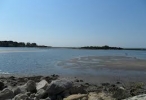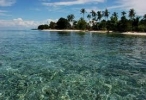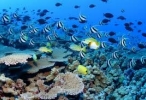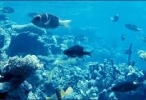VIR 2SYL
Using VirO2Syl Stabilized Hydrogen Peroxides In Sea Water For Remediation In The Ecosystem Of Marine And Plant Life Our product, VirO2Syl, is a stable form of hydrogen peroxide that is an important reactant in natural aquatic systems, environmental remediation technologies, and in biological systems. Reactive oxygen species, which include hydrogen peroxides H2O2 and hydroxyl radicals, OHd, which usually occur in rain and surface waters are factors that play an important role in the natural processes of aquatic systems, including radiolysis pyrite oxidation, and photochemical oxidation. Hydrogen peroxide also is intentionally added to wastewaters to promote insitu oxidation processes by leveraging the extreme reactivity of radicals toward organic pollutants. The generation of ·OH, via the decomposition of H2O2, degrades contaminants when methods involving microbiological degradation are ineffective. This accelerates the natural decomposition of organic carbon producing Oxygen and pure water.
If stabilized, hydrogen peroxide is a strong oxidizer effective in controlling sulfide and organic-related odors in wastewater collection and treatment systems. It is typically applied to a wastewater system where there is a retention time of 30 minutes to 5 hours before hydrogen sulfide is released.
Rain and snow contain hydrogen peroxide. Plants synthesize hydrogen peroxide during photosynthesis; so all fresh vegetables and fruits contain hydrogen peroxide. It is also generated by the lignifying xylem of many vascular plants (higher plants, for example, trees), which is very important for the plant metabolism. The planktons in the sea produce most of the world’s hydrogen peroxide in the sea. This is one of nature’s ways of purifying our seas.
Laboratory tests conducted by fish culturists in recent years have demonstrated that a catalyst using stable hydrogen peroxide can be used safely to provide oxygen for all species of fish. Hydrogen peroxide releases oxygen by decomposition when it is exposed to some catalyst
such as manganese dioxide. In one test, 25 fry (2 cm long) were put into each of two one-quart bottles of water. During a three-day period, 12 drops of stable hydrogen peroxide were added to one bottle, and none to the other. The result: 100 % of the treated fry survived and 100 % of the untreated fry perished.
The addition of a stable form of hydrogen peroxide to alkaline seawater provides an inexpensive, simple, and reliable method for the control and synchronous induction of broadcast spawning in males and females of certain bivalve and gastropod molluscs.
Species successfully induced by this method thus far include:abalones (Haliotis rufescens, H. corrugata, and H. fulgens), mussels (Mytilus edulis and M. californianus), purple-hinged rock scallop (Hinnites giganteus) and the mangrove oyster (Crassostrea rhizophora). Enzymological and physiological studies indicate that spawning may result from a peroxide-induced stimulation of the endogenous enzymatic synthesis of potent hormone-like prostaglandin molecules. Peroxide-stimulated prostaglandin synthetase also has been found in reproductive tissues of certain crabs and fishes, thus indicating potential applicability of this method for the control of reproduction in higher species.
There are many other advantages in the use of our products in the remediation markets.
Our product, VirO2Syl, is effective in both deep water applications and low water tables such as marshes and swamp areas. The most dramatic evidence of the immediate benefits of our product is in low water tables less than twelve feet where the ecosystems of plants and fish rely upon sunlight for photosynthesis and the production of oxygen for marine life. The decomposition of organic materials and fossil crude oil also produce oxygen when treated with our stabilized hydrogen peroxide. Our unique product, VirO2Syl, is a catalyst to this process and performs to meet these objectives in a very high performance
manner. VirO2Syl acts as a catalyst to oxidize lipids in oils and speeds its natural biodegradation. This oxidizing effect along with the polarization of the organic material of petroleum hydrocarbons will reduce the surface tension that stops oil and water from mixing. The oil molecules will polarize together allowing for mechanical collection without emulsification that forms large uncollectable tar compounds. The oil will coagulate into less dense layers that are more manageable for collection. The remaining residual molecules will be oxidized and will float on the top surface of the sea water instead of the sea bed where it can cause great damage to marine life in general.
The exposure to sunlight and marine plant life and other small marine organisms such as algae and planktons will metabolize the toxic molecules resulting in a rapid dilution of the oil by natural photosynthesis and the movement of water in sea currents. The formation of droplets also increases the oil surface area, thus increasing the exposure to natural evaporation and bacterial action. VirO2Syl will work long after the spill has been cleaned up, therefore it should be used in the deeper waters in higher concentrations to start the catalytic process, but it should also be used in lower water tables to protect the soil in coastal areas. It is important to understand that the most sensitive ecosystems are the coastal sea beds where the sandy beaches have a shallow water column that can affect marine organisms like low tidal water corals and sea grass.
The coastal waters have soil that will be contaminated by the oil spill. Once the oil has made it to the coast by tidal movements and water currents, our remediation product will provide the oxygen required to remediate the plant life in the coastal waters. This is important since the plants will not produce the sufficient oxygen to decompose the hydro carbons in the oil resulting in the death of plants and the marine life. The added oxygen will help the bacteria and microbes to digest the hydrocarbon. Some of the microbes will be oxidized, but this will allow the marine life to survive because the PH on the water will be stable so that both plants and larger sea mammals will have the eco-system balanced for their food supply.
Oxygen is the key. Four pounds of oxygen are required for one pound of hydrocarbon to be remediated. Much of this requirement will come from the atmosphere. When the hydrocarbons are below the surface of the water, the microbes get their oxygen from the water. A minimum of 1.5 mg/L DO is required. Surface agitation of air diffusion can be used to supply additional oxygen if required. The application of the product in areas that contain marine plants in coastal regions such as mangroves and sea oats, the product will allow the natural process of remediation to occur in a much more efficient manner. The mangroves can be sprayed with the product in the same manner as any pesticide is applied to control mosquito reproduction and the spread of parasite infestations.
In the coastal beaches and sandy areas where the ground is compacted, the ground should be tilled or raked to allow as much oxygen as possible to permeate the soil. The hydrated petroleum oxidizing catalyst can then be sprayed over the tilled soil. For best results, a moisture content of 30 to 40% of the soil’s holding capacity should be maintained (this equals around 10% for Gulf sands, up to 27% for compacted areas). The soil will be kept moist by the natural tidal activities. If it cannot be tilled, high-pressure injection of diluted hydrogen peroxide (500 ppm final dose) can be added to the soil to aerate it. The applications can be administered by conventional means of spraying equipment or vessels. This is important in order to minimize the cost in both equipment needs and labor as well.
Additional Benefits: Removal of Methane Gases in Water Columns:
VirO2Syl is a stabilized peroxide that acts as a peroxodisulfate. It is known to react with educing radicals and a-hydroxyalkyl radicals that produce OH or sulfate radicals,
respectively. This reaction may be due to either an electron transfer reaction or a radical substitution. The rate constants of these reactions are moderate. Methyl radical has been reported to react with hydrogen peroxide with a rate constant of 3.5 × 107 dm.
Hydrogen peroxide is used to inactivate cells, e.g. microorganisms. It can pass through the cell’s membrane and reach the DNA. Hydrogen peroxide reacts with adventitious transition metal ions yielding OH radicals via a Fenton-type reaction. The VirO2Syl product ratios that are formed under such conditions differ from those formed by OH radicals that were generated by ionizing radiation. This reaction will allow for the depletion of methane gases permeating into the atmosphere and the sea water where both plants and marine life require oxygen to survive. Petroleum produces Methane Thiols N.S.G.C. Natural Solutions Group Corp.
which are toxic in high levels to most marine mammals, fish and marine plant life. Our product, VirO2Syl will react with the methane gases by acting as a reducing agent and will form the bonds to render it safe to the Eco systems.
Methane Thiols are found in many industrial wastes, both liquid and gaseous thiols were called mercaptans. Although Methane thiols are toxic, they usually are found in very low concentrations and can be detected by smell in a concentration far below a toxic level.
They are not considered hazardous, but rather a nuisance, since the odor detection levels are in the order of parts per billion (PPB).
Hydrogen peroxide has been shown to effectively oxidize thiols over a range of temperatures and concentrations. Catalysis is sometimes required for vigorous oxidation.
VirO2Syl is stabilized and acts as a high performance oxidizer forming the catalytic effect required to process the Methane Thiols and reduce their concentrations to safe levels.
In the petroleum manufacturing process, methane thiol is formed by the demethylation of lignin. The petroleum thiols evolve from the decomposition of various sulfur containing compounds during the refining process. Thiols find application in ore flotation and are used or formed as byproducts in many chemical manufacturing processes, i.e., pharmaceuticals, insecticides, wetting agents, plastics, rubber additives. Thiols are formed also by bacterial decomposition of organic materials typically found in the rendering industry and at sewage treatment plants. The reaction occurs rapidly after mixing. The products are water insoluble disulfides which form an oily layer. This can be readily separated leaving behind only trace amounts of odorous material.
If methane thiol is present, or if a complete deodorization is desired, more rigorous oxidation is necessary. This requires all or some of the following: presence of catalyst, most conveniently in the form of a soluble iron salt (e.g., ferrous sulfate), excess hydrogen peroxide, and elevated temperatures. In salt water this process is accelerated by exposure to sunlight where the gases are converted to low to moderate levels combined with oxygen that is produced by the photo reaction and oxidative process of hydrogen peroxide.
There are many other advantages in the use of our products in the remediation markets.
The decomposition of organic materials and fossil crude oil also produce Oxygen when treated with a stabilized hydrogen peroxide. Our unique product, VirO2Syl, is a catalyst to this process and performs to meet these objectives in a high performance manner. It is critically important for the government officials to understand the long-term impact of this oil spill on our coastal areas. Although most of the oil is contained in the deeper waters as far as 100 miles offshore, the mechanical process of the collection of the oil is performed only on the surface, making it only possible to collect the organic material that is floating within two feet of the ocean surface.
It’s important to understand that as the oil becomes hydrated and more dense, it loses its surface tension and coagulates hundreds of feet below the ocean surface. This is an undisputable fact and can be confirmed by scientific surveys that have been conducted by oceanic scientists such as the organizations of Jacques Cousteau. The impact of a water column that is 100 feet in depth below the ocean surface will result in a tsunami-like saturation of the sea beds in the coastal areas where water tables are far less deeper. As this water column reaches the tidal shores, it will condense into higher densities of saturated lipids that are coagulated and will form huge tar-like compounds that will adhere themselves to all organic matter in the coastal areas. At that point, it would be virtually impossible to mechanically collect it by skimming or other means. This is vitally important to the coastal states that have beaches where the soil will have to be dredged in order to remove these contaminants. In the great State of Mississippi the river delta, which is the gateway of transportation for import and export in and out of the US,
will be highly compromised along with all other economies such as the fishing industries, where the silt deposits from the Mississippi River are naturally required to maintain the balanced eco systems that yield much of the shell fish and other marine species as an economic industry for all of the states like Mississippi ,Louisiana and Alabama . Other States like Florida that have hundreds of miles of coastal areas that are extremely delicate and vital to the thousands of species of fish ,birds and marine mammals. The wildlife will be endangered if a proactive approach is not implemented to protect one of the world’s natural wonders ,the Everglades National Preserve. The great state of Alabama faces the same losses as it’s Marsh areas are unlike any eco system in the world. Texas will also see a decline in the important economic dollars that drive it’s tourism and fisheries industry that rely upon clean water in the Gulf of Mexico.
VirO2Syl is safe for humans and wildlife and is the green solution that will be the most efficient and reliable science to use for the remediation phase of both the deep sea and the coastal shallow waterways and land areas.









